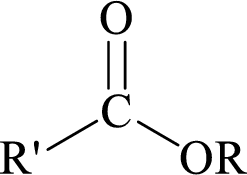
Interpretation: A mechanism has to be proposed for the given reaction.
Concept introduction:
Esters encompass a large family of organic compound with broad application in various fields of science and technology.
In Fischer esterification, a
Esters can be simply represented as,

Fischer esterification can be represented as follows,

Mechanism of the reaction is the step-by-step description of the process by which reactants are changed into products.
Curved arrows show the bonds that are formed and the bonds that are broken in a reaction.
Curved arrows used to understand a reaction mechanism.
Electrophile: It is positively charged species which seeks for negative charge and hence accepts pair of electrons from negatively charged species (Nucleophiles) which results in the formation of
Nucleophile: It is negatively charged species which seeks for positive charge and hence donate pair of electrons to positively charged species (electrophiles) which results in the formation of chemical bond.
Acid chlorides are organic compound and they have
Acid chlorides are most often prepared by treating a carboxylic acid with thionyl chloride.

Want to see the full answer?
Check out a sample textbook solution
Chapter 17 Solutions
Organic Chemistry
- When the conjugate acid of aniline, C6H5NH3+, reacts with the acetate ion, the following reaction takes place: C6H5NH3+(aq)+CH3COO(aq)C6H5NH2(aq)+CH3COOH(aq) If Kafor C6H5NH3+ is 1.35105 and Kafor CH3COOH is 1.86105 , what is K for the reaction?arrow_forwardWrite an equation for the reaction of chloroacetic acid (Ka=1.5103) with trimethylamine (Kb=5.9105) . Calculate the equilibrium constant for the reaction. If 0.10 M solutions of these two species are mixed, what will be their concentrations at equilibrium?arrow_forwardWhy are carbonyl compounds considered weakly acidic? Would you expect carbonyl compounds to be more acidic than alkanes? Explain.arrow_forward
- Isoamyl acetate is the common name of the substance most responsible for the characteristic odor of bananas. Write a structural formula for isoamyl acetate, given the information that it is an ester in which the carbonyl group bears a methyl substituent and there is a 3-methylbutyl group attached to one of the oxygens.arrow_forwardAldehydes and ketones undergo condensation reaction with 2, 4-dinitrophenylhydrazine. Write an equation for the reaction of 2, 4-dinitrophenylhydrazine with any one of the pheromones. What makes 2, 4-dinitrophenylhydrazine suitable for characterizing aldehydes and ketones?arrow_forwardIndicate the CORRECT alternative: a) Acid halides react only in the presence of a catalyst. b) The reaction of an acid chloride with an alcohol produces less of an ester than using the Fischer reaction. c) The nucleophilic substitution reaction in acid derivatives occurs through an SN1 mechanism. d) Reduction of an ester with LiAlH4 yields only secondary alcohols. e) Hydrolysis of an amide in an acid medium produces a carboxylic acid and a protonated amine.arrow_forward
- Upon completion of a chemical reaction, you find you have a mixture of benzoic acid and ethyl benzoate. Propose a procedure to separate the ethyl benzoate from the mixture. You should look up the structures of benzoic acid and ethyl benzoate.arrow_forwardWhy are acid/base catalysts required when producing esters from carboxylic acids and amides but not if acyl halides and acid anhydrides are used?arrow_forwardCarboxylic Acid Derivatives Resolve the reactions.arrow_forward
- Prepare CH3COOC2H5, ethyl acetate, using ethyl alcohol. Write the chemical reaction. The pain reliever acetaminophen is produced by reacting 4-aminophenol with acetic anhydride. Outline a synthesis of acetaminophen from 4-aminophenol including any needed inorganic reagents.arrow_forwardWhy can an acidic organic compound be separated from a neutral (neither basic nor acidic) organic compound?arrow_forwardb) Compounds in which the –OH of the carboxyl group is replaced by certain other groups are called carboxylic acid derivatives. The most important of which are acyl halides, acid anhydrides, esters and amides. Discuss the relationship between carboxylic acid, acid chloride and acid anhydridearrow_forward
 Chemistry: Principles and ReactionsChemistryISBN:9781305079373Author:William L. Masterton, Cecile N. HurleyPublisher:Cengage Learning
Chemistry: Principles and ReactionsChemistryISBN:9781305079373Author:William L. Masterton, Cecile N. HurleyPublisher:Cengage Learning Chemistry for Today: General, Organic, and Bioche...ChemistryISBN:9781305960060Author:Spencer L. Seager, Michael R. Slabaugh, Maren S. HansenPublisher:Cengage Learning
Chemistry for Today: General, Organic, and Bioche...ChemistryISBN:9781305960060Author:Spencer L. Seager, Michael R. Slabaugh, Maren S. HansenPublisher:Cengage Learning Organic ChemistryChemistryISBN:9781305580350Author:William H. Brown, Brent L. Iverson, Eric Anslyn, Christopher S. FootePublisher:Cengage Learning
Organic ChemistryChemistryISBN:9781305580350Author:William H. Brown, Brent L. Iverson, Eric Anslyn, Christopher S. FootePublisher:Cengage Learning


